Eritrea is a hidden gem in Africa, known for its ancient history, diverse cultures, and beautiful landscapes. It sits at the crossroads of Africa and the Middle East. This East African nation has unique attractions, like modernist architecture in Asmara and untouched Red Sea coasts.
Its culture is rich, thanks to nine ethnic groups and a blend of traditions. This makes Eritrea a place full of discovery.
Key Takeaways
- Eritrea’s location connects African and Middle Eastern cultural influences.
- It boasts dramatic highlands, Red Sea coastlines, and unique biodiversity.
- Historical sites like Asmara’s Art Deco buildings reflect its rich heritage.
- Its traditions and festivals celebrate unity among diverse communities.
- Eritrea remains a hidden gem with limited tourist infrastructure, offering authentic adventures.
Introduction to Eritrea: Africa’s Well-Kept Secret
Eritrea is a hidden gem in the Horn of Africa. It has ancient history and untouched natural beauty. It borders the Red Sea, Sudan, Ethiopia, and Djibouti, with landscapes that vary from rugged highlands to coastal plains.
Travelers find it a place where few tourists go. This makes it a treasure trove of hidden spots and top places to visit.
Geographical Location and Unique Landscape
Eritrea stretches from the Red Sea’s coral reefs to the highlands. The highlands are over 2,500 meters high. They contrast with the Danakil Depression’s volcanic landscapes.
The coastal areas, like the Dahlak Islands, have untouched beaches. The Gash-Barka lowlands are home to ancient rock art and fertile valleys.
Brief Overview of Eritrea’s Diverse Population
Eritrea is home to nine ethnic groups, including the Tigrinya and Saho. These groups share traditions and languages. Their customs, like coffee ceremonies and traditional music, are at the heart of Eritrean heritage.
This cultural mosaic is untouched by mainstream tourism. It makes Eritrea a unique place to explore.
Why Eritrea Remains Undiscovered by Mass Tourism
Eritrea gained independence in 1991 after a long struggle. It focuses on sustainable growth, not rapid tourism. This means many hidden spots are still unexplored.
Travelers are now discovering Eritrea’s beauty. They find history and nature living together in a unique way.
The Historical Significance of Eritrea
Eritrean history is deeply rooted in every corner of this East African nation. From ancient trade routes to colonial-era buildings, the land tells stories of resilience and change. The Axumite Kingdom once flourished here, linking the area to global trade across the Red Sea.
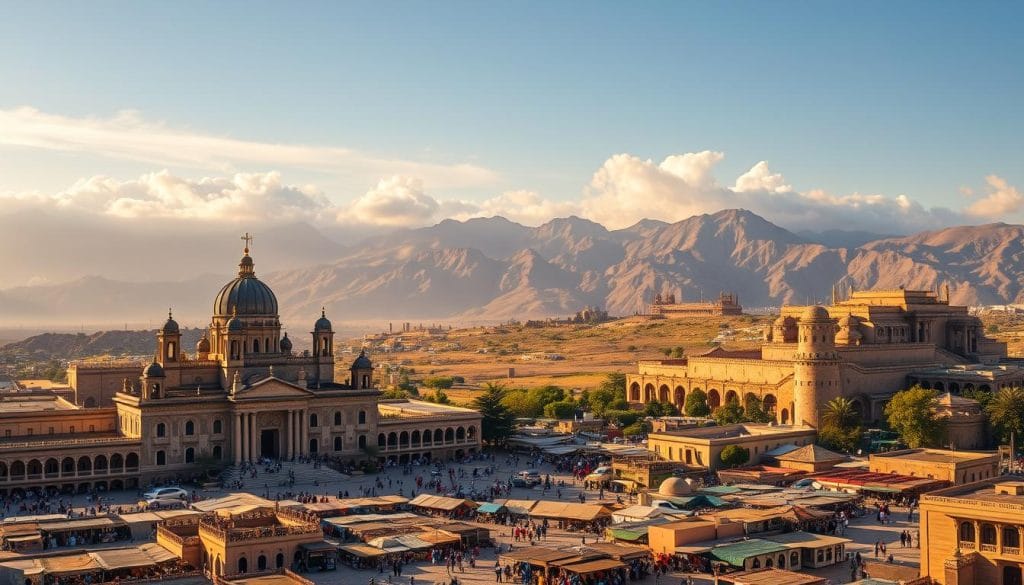 , stand as silent witnesses to this era. These architectural gems are now key tourist attractions, drawing history enthusiasts worldwide.
, stand as silent witnesses to this era. These architectural gems are now key tourist attractions, drawing history enthusiasts worldwide.
Eritrea’s fight for independence from Ethiopia lasted three decades, ending in 1991. Monuments like the Independence Memorial Museum in Asmara honor this struggle. Visitors get a glimpse into the nation’s Eritrean history. Guides share tales of bravery, blending education with travel.
Visitors may wonder, “Is safe to visit?” Eritrea’s government prioritizes stability today, ensuring sites like the Nefasit War Panorama are accessible. Travelers exploring historical sites like the Stelae Fields near Qedemawi can experience ancient and modern narratives safely.
What Is The Speciality of Eritrea: Cultural Identity
Eritrean culture is all about unity in diversity. Nine ethnic groups make up the nation, each with their own traditions, languages, and customs. Solo travelers find unique experiences here that they can’t find anywhere else.
The Nine Ethnic Groups and Their Traditions
- Tigrinya: Known for vibrant festivals and Orthodox Christian heritage.
- Tigre: Celebrates pastoral traditions and Islamic practices.
- Kunama: Preserves animist rituals tied to nature and ancestral spirits.
- Nara: Honors oral histories through storytelling and music.
- Bilen: Maintains distinct pottery and agricultural practices.
- Saho, Afar, Hedareb, and Rashaida: Each group adds layers to Eritrea traditions, from nomadic lifestyles to coastal fishing customs.
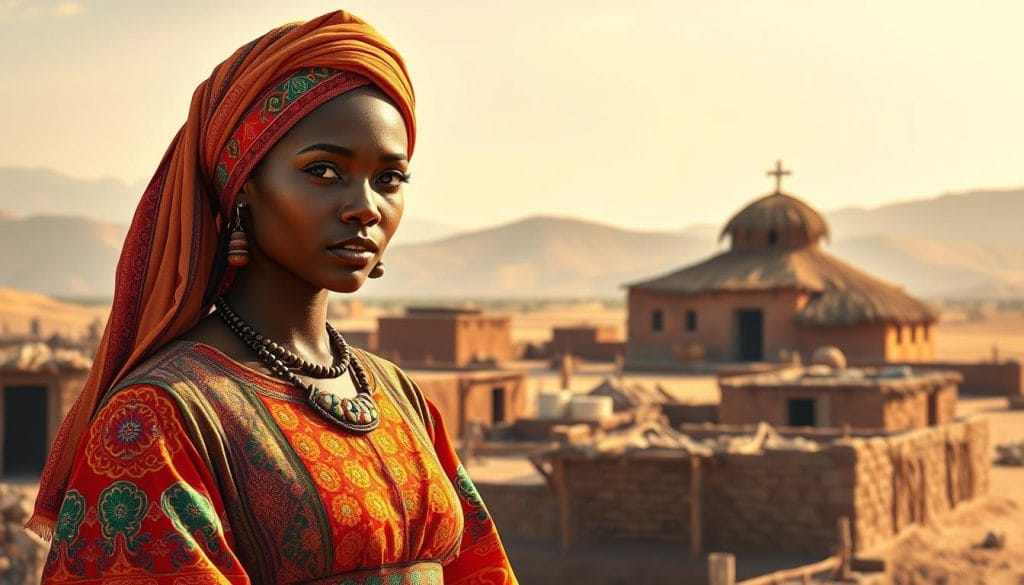
Languages and Communication
Tigrinya and Arabic are official languages, but English is common in cities. Locals who speak many languages help solo travelers connect with the community. This makes experiences like staying in a village home possible.
Traditional Clothing and Artistic Expressions
The zuria, a white embroidered dress, represents purity for Tigrinya women. Men wear enda cloaks and handwoven textiles that show off regional art. These clothes are key to celebrations and cultural events.
Religious Diversity and Coexistence
“Mosques and churches stand side by side—proof that faith unites here,” says a local elder.
Orthodox Christians, Catholics, and Muslims live together, sharing spaces and holidays. This shows how faith brings people together. Travelers can see this unity at events like Easter or Eid.
Exploring village markets and highland festivals, solo travelers dive into Eritrean culture. Here, respecting diversity is as important as the traditions themselves.
Eritrean Cuisine: A Blend of African and Middle Eastern Flavors
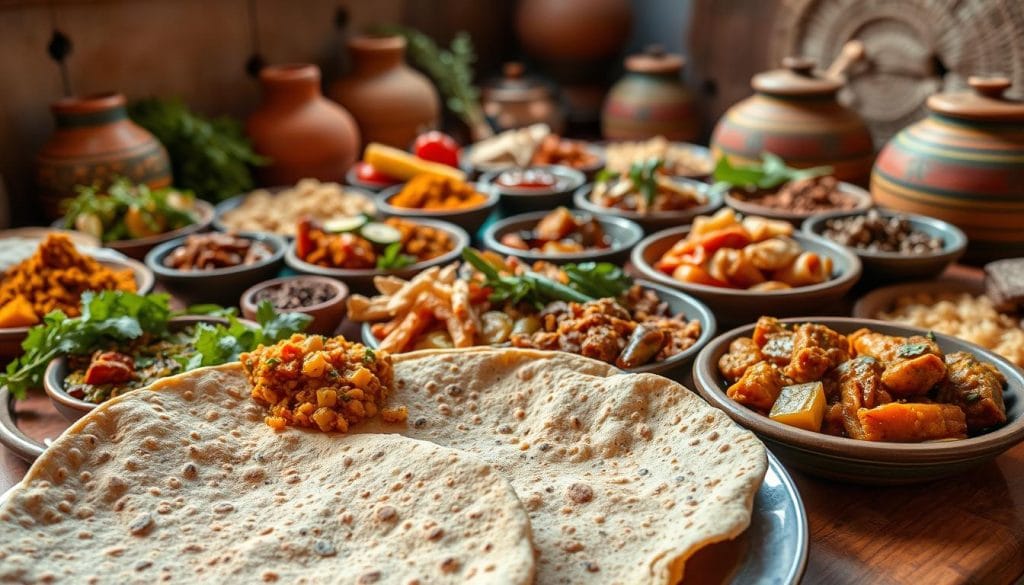
Eritrean cuisine is a mix of African and Middle Eastern tastes. It comes from centuries of trade and cultural sharing. Families can enjoy family vacation spots where meals are more than just food.
From lively markets to seaside eateries, trying local dishes is a must. It’s a key part of things to do in Eritrea.
“A meal without injera is like a book without pages.” — Traditional Eritrean saying
Injera: The Staple Food of Eritrea
Injera, a spongy flatbread, is made from teff flour. It’s used as both a plate and a utensil. Families use it to scoop stews like zigni or shiro.
At Asmara’s Embady Restaurant, injera is a family tradition. They perfect its sourdough fermentation.
Zigni and Other Traditional Dishes
- Zigni: A spicy meat stew with berbere and peppers.
- Shiro: A chickpea stew with mild spices.
- Kitcha Fit-fit: Crumbled injera with clarified butter and spices.
- Seafood: Coastal towns have grilled tilapia and octopus.
Coffee Ceremony: A Cultural Institution
The coffee ceremony shows Eritrea’s hospitality. Families roast green beans over embers. They serve three rounds—abol, tona, bereka—with popcorn or roasted grain.
Visitors can learn this tradition at workshops. It’s a blend of tradition and interactive family vacation spots.
Unique Spices and Ingredients
Berbere, a chili blend, is key in many dishes. Mint, garlic, and korar t’olia (rock salt) add flavor. Markets like Asmara’s Arada Bazaar let travelers buy spices directly.
This is a must for things to do in Eritrea.
Asmara: A Modernist Architectural Wonder
Asmara, Eritrea’s capital, is a living museum of early 20th-century architecture. It was declared a UNESCO World Heritage Site. Its streets show over 400 examples of Art Deco, Futurist, and Rationalist designs.
The city’s historic buildings and lively urban life make it unique. It stands out among Eritrea attractions.
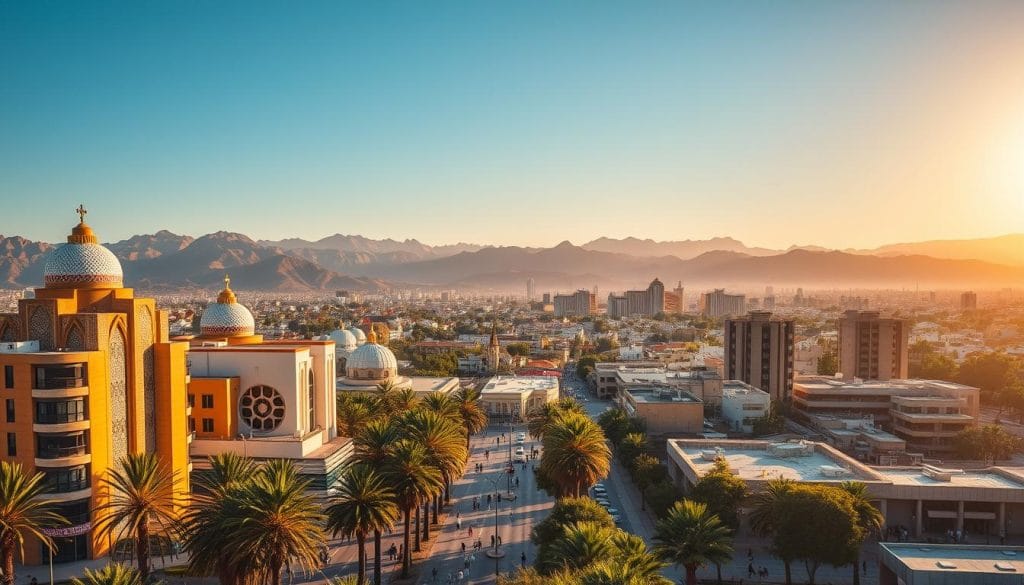
- Fiat Tagliero: A cantilevered gas station that looks like an airplane.
- Cinema Impero: A 1938 cinema with geometric patterns and marble floors.
- Opera House: A 1930s theater showing Italian colonial grandeur.
These structures survived intact because of Eritrea’s political isolation. They were frozen in time. Visitors can explore these Eritrea attractions on guided tours or self-guided walks.
The best time to visit Asmara is October to March. The weather is mild during this time. An ideal itinerary includes highlights like Piazza Italia’s cafes and the National Museum.
Cafés like Caffè Giardino offer espresso in historic settings. They blend architecture with local culture.
The Red Sea Coast: Eritrea’s Natural Treasure
Eritrea’s 1,200 km Red Sea coastline is home to some of the world’s most untouched coastal areas. It’s a top best travel destinations for those who love nature. The waters are full of vibrant ecosystems and historic treasures, making it perfect for adventure travel and eco-friendly travel.
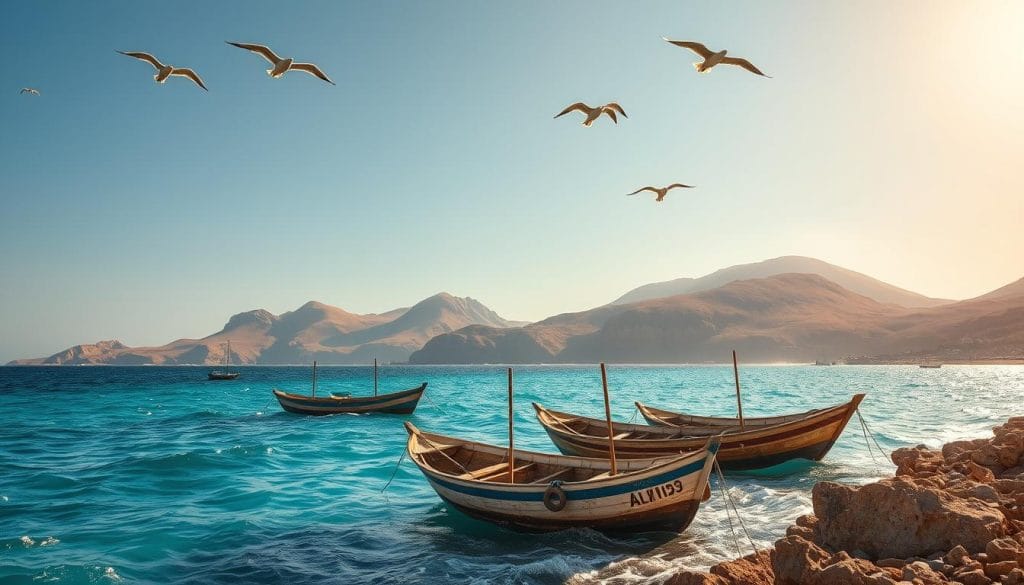
Dahlak Archipelago: Pristine Marine Paradise
This archipelago has over 200 islands with turquoise waters, coral gardens, and secluded beaches. Islands like Dahlak Kebir and Hanaqouh are untouched, keeping their beauty alive. Snorkelers and divers see parrotfish, sea turtles, and rare marine species in the reefs.
Diving Opportunities in Unspoiled Waters
- Healthy coral systems rank among the healthiest in the Red Sea.
- Historic shipwrecks from ancient trade routes lie at accessible depths.
- Guided tours highlight sites like the 19th-century Egyptian schooner El-Mina.
Coastal Communities and Their Way of Life
Local Afar and Rashaida communities fish sustainably using traditional methods. Their long history of sea reliance has kept the environment intact, fitting global eco-friendly travel standards. Visitors can learn about boat-building or try fresh seafood in seaside villages.
Exploring Eritrea’s Red Sea coast is a chance to see untouched beauty and support conservation. Whether diving or sailing, travelers find a place where adventure and ecological respect meet.
Traditional Crafts and Artisanship
Handcrafted goods in Eritrea show the nation’s rich artistic heritage. From pottery to jewelry, these items are perfect for those looking for unique, affordable souvenirs. Visiting workshops and markets helps travelers save money and supports local artisans.
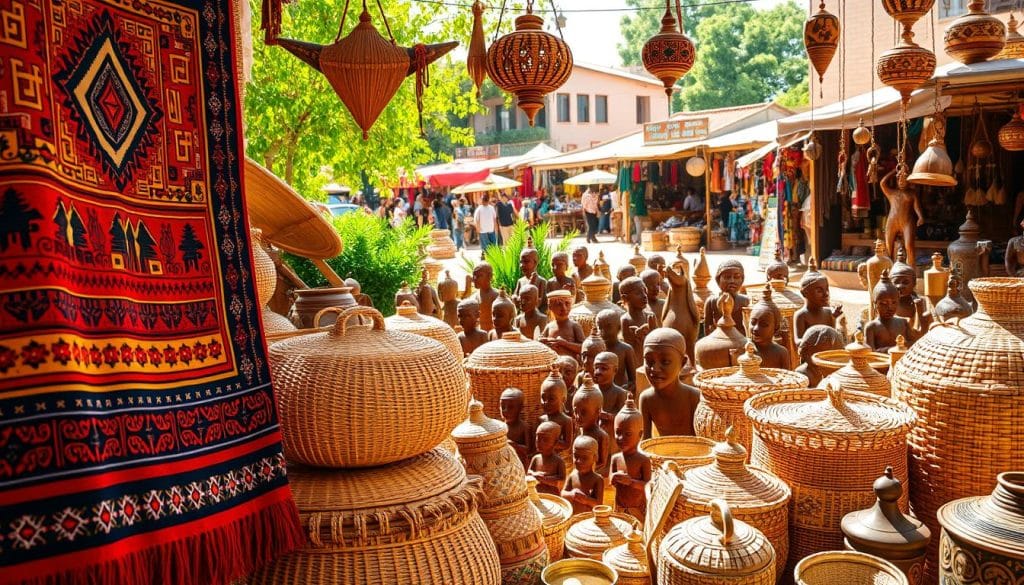
Pottery and Ceramics
Artisans make useful and beautiful items like the mogogo (clay oven) and jebena (coffee pot). These pieces are made from local clay and often feature geometric designs. At Mendefera cooperatives, visitors can see potters at work and buy items for half the price of tourist shops.
Buying here not only saves money but also helps keep traditional techniques alive.
Basket Weaving and Textile Arts
Colorful mesob baskets and handwoven cotton shawls display intricate patterns. Textiles like the enda shawl, worn by both men and women, are affordable at village markets. Buying directly from weavers means better value, with a mesob costing $10–15, compared to $30+ in Asmara stores.
Jewelry Making and Metalwork
Silver filigree crosses and anklets are symbols of Eritrean craftsmanship. Artisans in Keren and Massawa sell these items at 30–50% lower prices than in cities. By bargaining politely and visiting cooperatives like the Eritrea Handicrafts Association, travelers can find great deals without sacrificing quality.
| Craft Type | Products | Cost Savings |
|---|---|---|
| Pottery | Mogogo, Jebena | 30–40% cheaper at cooperatives |
| Basketry | Mesob, Shawls | Avoid tourist zones for better prices |
| Jewelry | Silver filigree | Direct purchases cut retail markups |
Supporting artisans is key to sustainable travel. These crafts not only showcase Eritrea’s traditions but also provide budget-friendly travel tips for those who travel mindfully.
Festivals and Celebrations in Eritrea
Eritrea’s tourism shines with its lively festivals. These events give visitors a deep dive into the culture. A travel guide to Eritrea must include these colorful celebrations.
Independence Day (May 24) celebrates Eritrea’s freedom with parades and dances. Martyrs’ Day (June 20) honors heroes with ceremonies and performances. Festival Eritrea in August showcases music, crafts, and food from all ethnic groups.
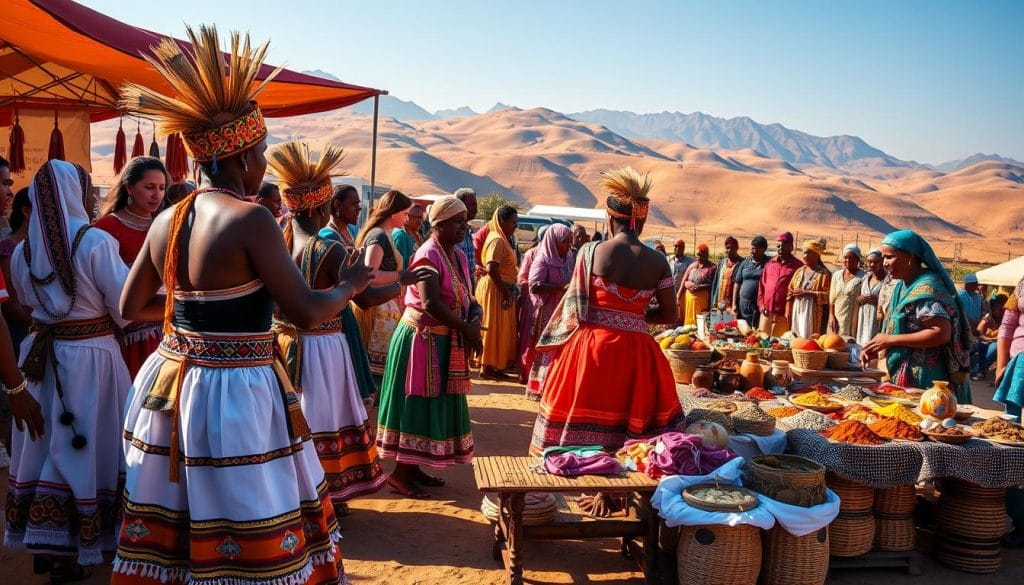
Religious festivals like Meskel (September), Eid, and Christmas mix spirituality with joy. Meskel’s flame-lighting and Easter processions attract many. Eid brings feasts and family time.
Respect is key when attending these events. Ask before taking photos and dress modestly. This shows respect for the culture.
“Festivals are the heartbeat of Eritrean culture,” says a local guide. “They’re moments when traditions come alive.”
Plan ahead for peak events like Festival Eritrea. A good travel guide will suggest the best insurance for these activities. Budget for local crafts and expect lively markets.
Attending these festivals offers a deep look into Eritrea’s spirit. Dancing to drums or trying zigni or injera are unforgettable experiences.
Eritrea’s Natural Wonders Beyond the Coast
Eritrea’s interior is full of hidden treasures, far from the Red Sea. The highlands, Semenawi Bahri’s green valleys, and untouched ecosystems offer unique escapes. These places mix adventure with cultural learning, perfect for those looking for luxury travel experiences.
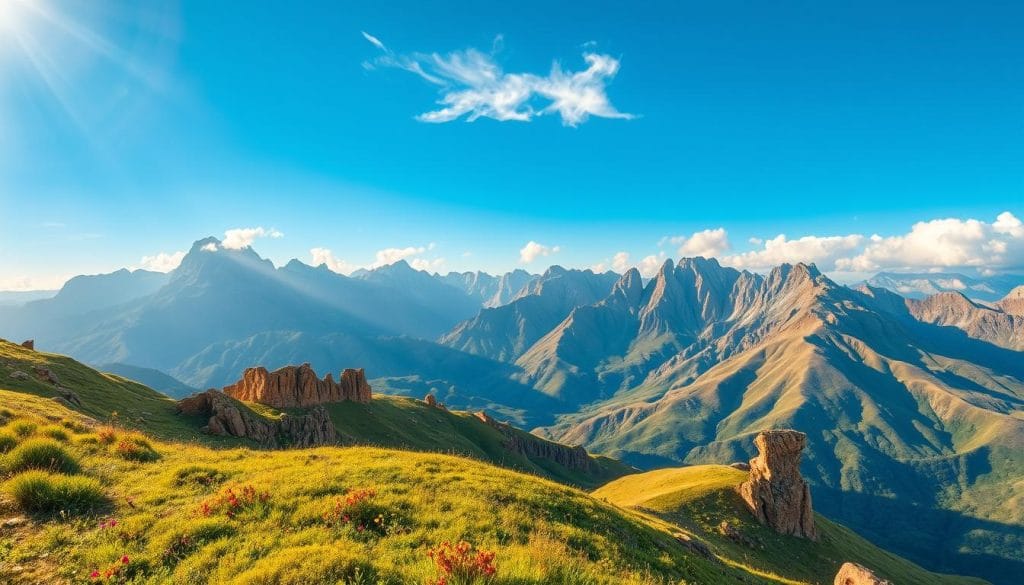
The Highland Regions and Their Biodiversity
The highlands are over 2,500 meters high, with dramatic cliffs and valleys. They are home to unique plants and animals. Visitors can see terraced farmlands and forests where rare species live.
Trails in places like Gash Barka offer views of acacia woodlands and waterfalls.
Semenawi Bahri: Eritrea’s Green Belt
This northern region has cloud forests and misty hills. It’s a beautiful contrast to the dry lowlands. Traditional villages show old farming ways.
Guests can stay in eco-lodges among coffee plantations or visit homestays. These places highlight local culture.
Wildlife Unique to the Region
- Birdwatchers can see over 560 species, including the endangered Houbara bustard.
- Hamadryas baboons and Eritrean gazelles can be seen in open plains and remote valleys.
- Rare leopard sightings happen in places like the Danakil Depression’s edges.
For travelers, where to stay in Eritrea’s highlands includes luxury tented camps and family-run guesthouses. Minibuses connect major towns, but 4×4 tours with local guides are best for remote areas. Exploring these landscapes offers a chance to see nature untouched by mass tourism, blending adventure with cultural respect.
Planning Your Trip to Eritrea: Essential Information
Before you start your trip, learn about visa requirements for Eritrea. U.S. citizens and many others need a tourist visa. You can get it at Eritrean embassies or consulates. You’ll need a passport good for six months, a visa form, and proof of your next travel plans.
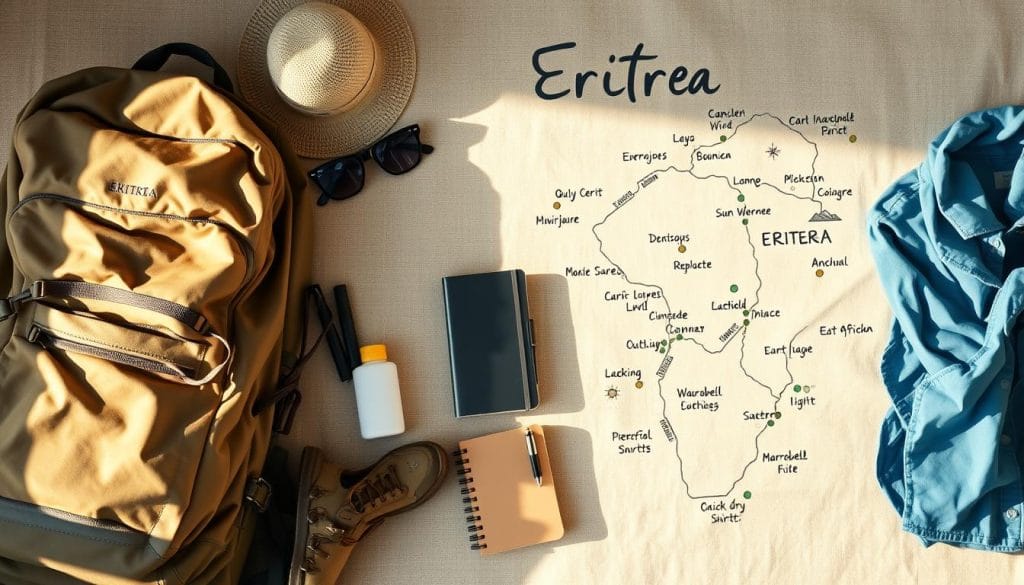
Make sure you have the right permits for places outside Asmara. Get these from the Ministry of Tourism or licensed tour operators. Then, make a detailed travel packing list.
Bring clothes that are light for the coast and warm for the highlands. Don’t forget sun protection, good shoes for hiking, and a first-aid kit. You’ll need a universal adapter for your electronics, and internet is rare outside cities.
When how to plan a trip to Eritrea, think about money. The local currency is Nakfa. ATMs are few, so bring U.S. dollars for exchange. The best time to visit depends on where you go.
Coastal areas are best from November to April. Highlands are cooler from June to September. Check health advisories for needed vaccinations like hepatitis A and typhoid.
- Carry a printout of travel permits for border checks.
- Respect local customs: dress modestly in rural areas.
- Book accommodations in advance, especially during festival seasons.
Eritrea’s tourism is still growing. Be flexible and work with local guides. With good planning, you’ll see the country’s beauty, from Asmara’s art deco to the Dahlak Islands’ reefs.
Accommodations and Transportation in Eritrea
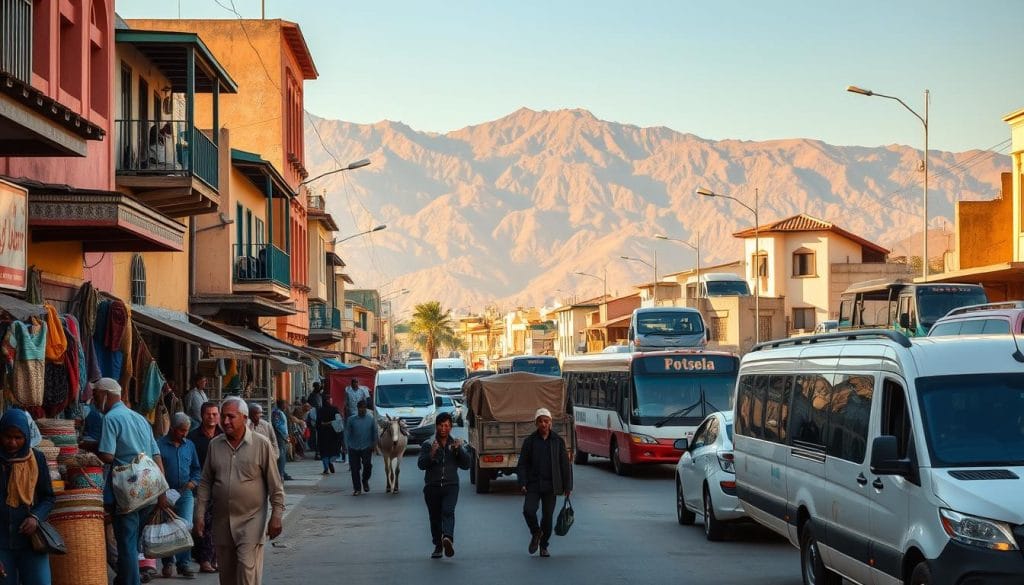
Exploring Eritrea’s hidden gems starts with smart planning. Travel hacks for navigating its unique infrastructure can make a big difference. From luxury stays to budget-friendly options, accommodations reflect the country’s diverse character.
Where to Stay: From Luxury to Budget Options
Luxury seekers head to Asmara Palace Hotel, a historic landmark in the capital. Boutique hotels in colonial-era buildings offer charm, while guesthouses and local hotels provide affordable stays. Homestays in rural areas let travelers experience authentic Eritrean life. Cheap travel tips include booking ahead for peak seasons and opting for community-run lodgings.
Getting Around: Transportation Infrastructure
Domestic flights connect major cities like Asmara and Massawa, though schedules are limited. The scenic but intermittent rail line from Asmara to Massawa is a highlight when operational. Public buses and shared taxis are cost-effective, but roads vary in quality. Private car hire with drivers is recommended for flexibility. Always confirm routes and road conditions before departure.
Travel Tips for First-Time Visitors
- Research transportation options early; avoid unmarked taxis to prevent travel scams to avoid.
- Negotiate fares in advance for shared rides or private tours.
- Local eateries and markets offer cheap travel tips—try injera at family-run restaurants.
- Carry cash for small transactions and learn basic Tigrinya phrases for smoother interactions.
“Respect local customs, like asking permission before photographing people or cultural sites.”
The People of Eritrea: Hospitality and Resilience
Eritrean culture is all about warmth and unity. Visitors often say locals are very generous. They share meals and help strangers find their way.
A coffee ceremony or a shared injera meal teaches about living together. This comes from years of facing challenges together. It has made their bonds strong.
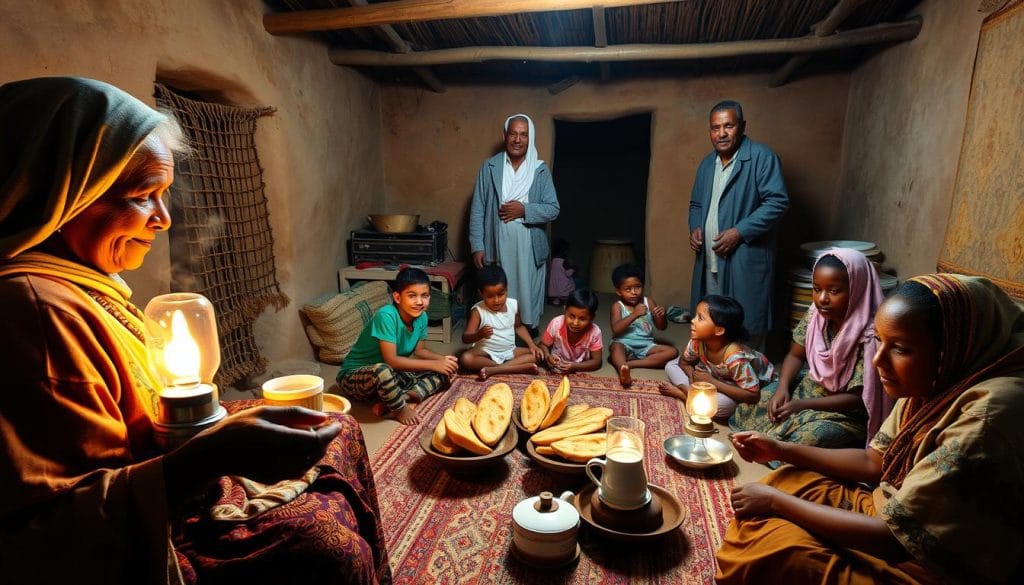
“Hospitality is not a choice—it’s a way of life,” says a local elder. “A traveler’s story becomes our story.”
Family vacation spots in Eritrea are special. Kids can learn to weave or join harvest festivals. It’s important to respect their customs.
Here’s how to connect:
- Learn basic greetings: “Salam” (hello) or “Mestet” (thank you).
- Ask permission before photographing people or homes.
- Visit markets to buy crafts directly from artisans.
A travel guide to Eritrea should focus on people. Locals might invite you to weddings or religious events. This shows how much they value being together.
Stories are a big part of Eritrean families. Every meeting is a chance to connect. By respecting their traditions, you’ll leave as a friend, not just a tourist.
Sustainable Tourism and Responsible Travel in Eritrea
“Sustainable tourism isn’t just a trend—it’s a lifeline for Eritrea’s future.” – Eritrean Ministry of Tourism
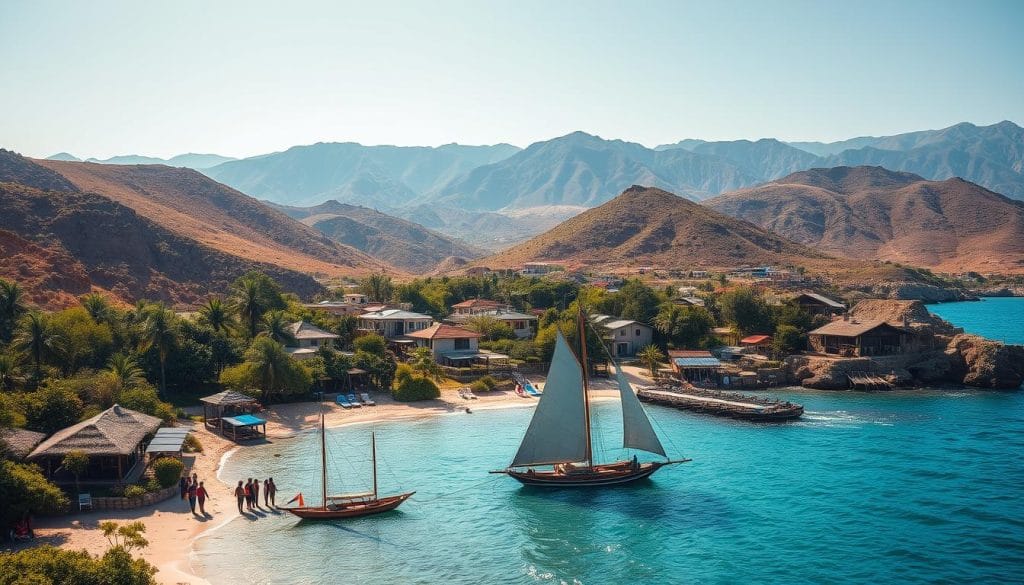
Visiting Eritrea with care helps its landscapes and traditions last. Making responsible travel choices helps communities and keeps heritage alive. Here’s how to plan a trip that supports Eritrea’s conservation and cultural values.
Economic Impact of Tourism
Every traveler’s choices have an impact. Stay in locally owned guesthouses and hire certified guides to help rural economies. This supports artisans and small businesses, reducing dependence on agriculture. Travel hacks for ethical tourism include:
- Purchasing crafts directly from workshops
- Choosing tours led by community cooperatives
- Learning about fair-trade practices
Environmental Conservation Efforts
Eritrea’s ecosystems face threats like coral bleaching and deforestation. Visitors can help by:
- Avoiding single-use plastics to protect marine life
- Sticking to marked trails in national parks
- Choosing eco-friendly travel operators certified by local authorities
Beachfront resorts and diving companies now use solar energy. This reduces carbon footprints and showcases Red Sea wonders.
Cultural Preservation Initiatives
Traditional crafts are at risk without support. To plan a trip to Eritrea with cultural respect, consider:
- Visiting how to plan a trip to include workshops with potters in Keren or weavers in the highlands
- Exploring the National Museum’s efforts to digitize oral histories
- Respecting sacred sites and asking permission before photographing rituals
Small actions can make a big difference. Travelers who choose eco-friendly travel and community engagement help Eritrea grow sustainably. Their responsible choices today protect Eritrea’s treasures for future generations.
Safety Considerations and Travel Advisories
Many ask: is safe to visit? Eritrea has low crime rates in tourist spots. But, it’s wise to be careful outside big cities. Always check the latest government travel advisories, especially for areas like the Red Sea coast or Gash-Barka zone.
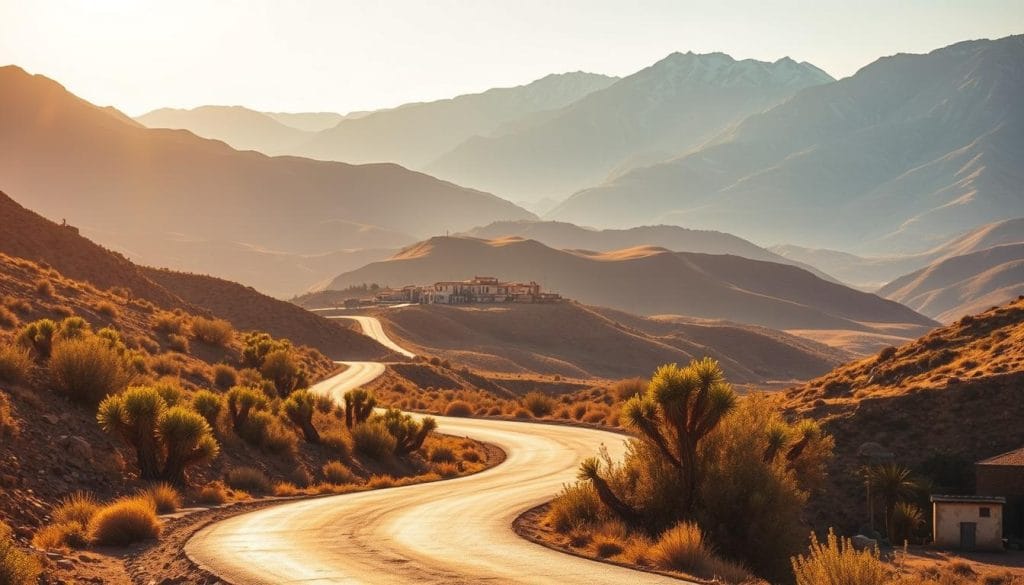
Health is a big concern. Talk to a doctor about taking malaria meds for low-lying areas. Stick to bottled water and avoid raw street food. Asmara’s hospitals can handle basic care, but best travel insurance is crucial for medical evacuations. Look for policies from Allianz or World Nomads that cover remote and adventurous areas.
- Travel scams to avoid: Most scams come from unofficial currency exchanges. Always use official banks to save on fees.
- Photography rules are strict near military and government buildings. Always ask locals before taking photos of people or buildings.
| Insurance Must-Haves | Why It Matters |
|---|---|
| Medical Evacuation | Remote areas may lack advanced care |
| Adventure Coverage | Rugged terrain requires specialized policies |
| Political Unrest | Check if policies cover border zones |
Always use licensed guides for desert or highland trips. Carry all necessary permits for travel beyond Asmara. With careful research and planning, you can enjoy Eritrea’s beauty safely and responsibly.
Conclusion: Why Eritrea Deserves a Place on Your Travel Bucket List
Eritrea is a hidden gem, untouched by many. Its cities, like Asmara, show off art deco wonders. The Dahlak Archipelago’s coral reefs are a sight to see. Each place tells a story of strength and tradition.
The culture here is rich and unique. You can see it in festivals, handmade crafts, and the friendly locals. It’s a chance to see a world untouched by too many tourists.
Getting there might need some planning, but it’s worth it. You can take a private yacht to secret coves or stay in historic Asmara. For those on a budget, homestays and craft workshops let you connect with locals and support their economy.
The food is amazing, with dishes like injera and zigni. The country’s religious harmony and natural beauty, like Semenawi Bahri’s forests, are waiting to be explored. It’s a place where you can travel responsibly and respect the culture and environment.
Now is the time to explore Eritrea. It’s a place where you can truly discover something new and authentic. Don’t miss out on this hidden gem before it becomes too popular.
